This guide explores the fascinate world of what do axolotls eat! From their wild hunting grounds to your home aquarium, we’ll delve into the essential nutrients these unique creatures need to thrive.
Ever Wonder What do Axolotls Eat?
These adorable salamanders with their feathery gills and playful personalities have captured the hearts of many. But what exactly fuels these fascinating creatures? Unlike your goldfish or hamster, axolotls are obligate carnivores. This means they gotta have their meat!
Imagine a tiny underwater T-Rex. That’s kind of what axolotls are like when it comes to their diet. They need protein to grow strong and healthy. In the wild, they act like nocturnal hunters, waiting until nightfall to snatch up yummy treats.

So, what kind of goodies are on their menu? Think worms wiggling in the mud, tiny crustaceans like water fleas, and even the occasional insect that takes a tumble into the water.
Think of it as a Mexican buffet for these little guys! We’ll delve deeper into their wild diet and how to translate it to their captive environment in the next section. But for now, remember: axolotls are all about the protein to keep them happy and healthy!
Axolotls in the Wild: A Diverse Dinner Plate (what do axolotls eat)
Imagine a lush lake in Mexico teeming with life. This is where axolotls find their natural smorgasbord! As obligate carnivores, they need a variety of protein-rich foods to thrive. But what exactly fills their plates in the wild?
Think of it like a buffet with all sorts of tasty morsels:
Wiggly Worms:
Earthworms and other worm varieties are a common and nutritious snack for axolotls. They’re easy to catch and packed with protein.

Crustacean Crunch:
Tiny crustaceans like water fleas (daphnia) are another favorite. These little guys are like aquatic shrimp, offering a protein and calcium boost.

Insect Surprise:
The occasional insect that takes a tumble into the water becomes an unexpected treat for an axolotl. Think of it like a bonus protein bar!

Fishy Feast:
Small fish might also find themselves on the menu, especially for larger axolotls.
Interestingly, some axolotls might even ingest some gravel or pebbles. It’s believed this helps with digestion by grinding up their food.
Who knew these cute salamanders had such a varied diet in the wild? In the next section, we’ll explore how to translate this knowledge into creating a balanced and delicious meal plan for your pet axolotl!

Feeding Your Axolotl: A Captive Culinary Adventure!
So, we’ve learned that axolotls are protein-powered predators in the wild. But how do we translate this knowledge to feeding our pet axolotls in a home aquarium? Don’t worry, it’s not as complicated as it might seem!
Here’s a breakdown of some delicious and nutritious options to keep your little buddy happy and healthy:

Live Food Buffet:
Blood-worms, earthworms, black worms, and brine shrimp are all excellent choices. Imagine them like tiny underwater hot dogs – packed with protein and irresistible to axolotls!

Frozen Feast:
For a convenient alternative, thawed blood-worms and daphnia are great options. Think of them like yummy fish sticks for your axolotl!

Pellet Power:
Specially formulated axolotl pellets can be part of a balanced diet. They’re like little vitamin-packed kibble for your pet, providing essential nutrients in an easy-to-eat form.

Important Considerations for a Healthy Axolotl: Beyond the Yum Factor!
We all love to spoil our pets with delicious treats, but when it comes to axolotls, there are a few things to keep in mind beyond just the “yum factor.” Here’s a quick guide to some important considerations for a healthy axolotl diet:

Veggie No-No! (what do axolotls eat)
While those veggies in your fridge might look tempting, axolotls simply can’t digest them well. In fact, feeding them vegetables can lead to health problems.

Raw Meat Risk: (what do axolotls eat)
Raw meat can harbor harmful bacteria, so avoid it altogether. Stick to the protein sources we mentioned earlier that are specifically suited for axolotls.

Feeder Fish Frenzy – Not Always a Good Idea:
Feeder fish can introduce diseases to your axolotl and might even be too big for them to swallow safely. It’s best to stick to the recommended food options.

Spotting Malnutrition:
Just like us, axolotls can become malnourished if their diet isn’t balanced. We’ll discuss some key signs to watch out for in a later section, so you can keep your axolotl healthy and thriving.

Vitamin Supplements – Not Always Necessary: (what do axolotls eat)
A well-rounded diet usually provides all the vitamins and minerals your axolotl needs. However, there might be situations where supplements are recommended. We’ll explore this in more detail later.
Remember, responsible pet ownership means providing your axolotl with the right food to keep them healthy. By following these simple guidelines, you can ensure your little guy gets all the nutrients they need to live a long and happy life!

Addressing Special Needs: Every Axolotl is Unique!
Just like us humans, axolotls can have special needs when it comes to their diet. Here’s what to keep in mind if your little guy falls into this category:

Food Allergies:
Believe it or not, axolotls can develop allergies to certain foods, just like some people are allergic to peanuts. If you suspect your axolotl has a food allergy, consult a veterinarian to identify the culprit and adjust their diet accordingly.

Injury Recovery:
Axolotls with injuries might require softer foods that are easier to eat. Chopped earthworms or bloodworms can be a good option during healing periods.
Remember, consulting a veterinarian is always recommended when your axolotl has special needs. They can help you create a personalized feeding plan to ensure your pet gets the proper nutrients to heal and stay healthy.
In the next section, we’ll delve into some responsible feeding practices to keep your axolotl happy and thriving!

Beyond the Basics: Responsible Feeding Practices for Happy Axolotls
Feeding your axolotl isn’t just about throwing some food in the tank and calling it a day! Here are some responsible practices to keep your little guy healthy and prevent any unwanted surprises:

Spotting a Chubbylotl:
Just like us, axolotls can overeat! Signs of an overfed axolotl might include lethargy, decreased activity, or a bulging belly. If you notice these signs, adjust their feeding frequency or portion sizes.

Fresh Food Matters:
Especially when using live food options like bloodworms or brine shrimp, keeping them fresh is essential. Uneaten live food can decompose and foul the water, so make sure to remove any leftovers after feeding time.

Ethical Eating:
Where your feeder insects come from matters! Consider reputable sources that prioritize humane breeding practices. Some pet stores even sell pre-packaged, frozen insect cubes specifically for axolotls, which can be a convenient and ethical option.
By following these responsible feeding practices, you’re not only keeping your axolotl healthy but also contributing to a sustainable pet ownership approach. In the next section, we’ll wrap things up and explore some resources to help you on your axolotl care journey!

Wrapping Up: A Well-Fed and Happy Axolotl!
By providing your axolotl with a balanced diet and following responsible feeding practices, you’re setting them up for a long and healthy life. Remember, these fascinating creatures may look like they could survive on a diet of goldfish crackers, but they truly thrive on a specific nutritional plan.
This guide has hopefully given you a solid foundation for understanding your axolotl’s dietary needs. But remember, every axolotl is unique! Consulting with a veterinarian is always recommended, especially if you have any concerns about your pet’s health or specific needs.

Understanding Your Axolotl’s Diet: A Guide to Balanced Nutrition
This guide dives into the fascinating world of axolotl diets! From their wild hunting grounds to your home aquarium, we’ll explore the essential nutrients these unique salamanders need to thrive.

1. Axolotls: The Obligate Carnivores
Axolotls are captivating salamanders with a permanent child-like appearance. But don’t let their cute looks fool you; these are obligate carnivores, meaning they require a protein-rich diet to maintain optimal health. In the wild, they act as nocturnal hunters, using their suction power to capture prey.

Think of them as tiny underwater lions! They stalk their prey in the dark, using their sensitive snouts to detect movement. Their diet consists of a variety of protein sources, which we’ll explore in the next section.
Axolotls in the Wild: A Diverse Dinner Plate
Imagine a lush lake in Mexico teeming with life. This is where axolotls find their natural smorgasbord! As obligate carnivores, they need a variety of protein-rich foods to thrive. But what exactly fills their plates in the wild?
Think of it like a buffet with all sorts of tasty morsels:
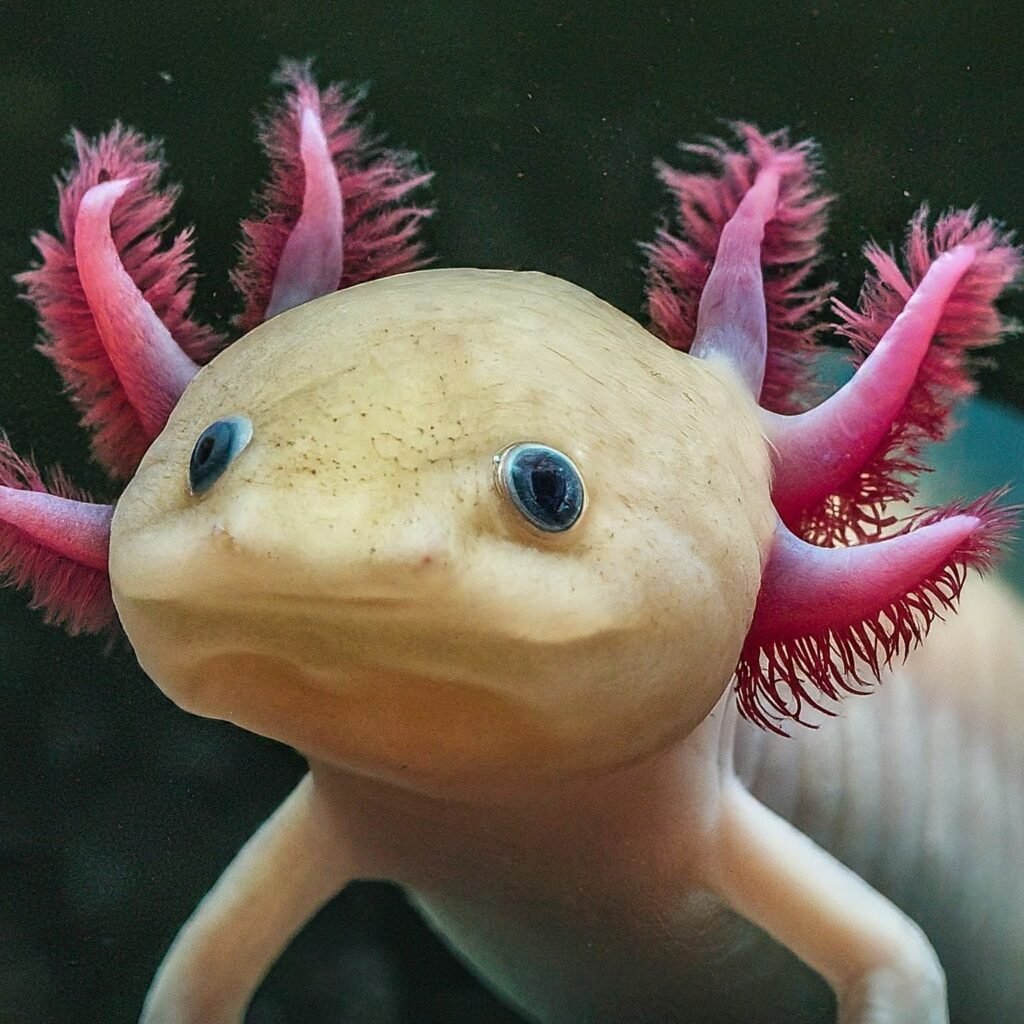
Wiggly Worms:
Earthworms and other worm varieties are a common and nutritious snack for axolotls. They’re easy to catch and packed with protein for growth and repair.

Crustacean Crunch:
Tiny crustaceans like water fleas (daphnia) are another favorite. These little guys are like aquatic shrimp, offering a protein and calcium boost for strong bones and muscles.

Insect Surprise:
The occasional insect that takes a tumble into the water becomes an unexpected treat for an axolotl. Think of it like a bonus protein bar, providing a quick burst of energy!

Fishy Feast:
Small fish might also find themselves on the menu, especially for larger axolotls. Fish provide a good source of protein and essential fatty acids for overall health.
Interestingly, some axolotls might even ingest some gravel or pebbles. It’s believed this helps with digestion by grinding up their food in their stomachs, similar to how birds use gizzards.
Who knew these cute salamanders had such a varied diet in the wild? In the next section, we’ll explore how to translate this knowledge into creating a balanced and delicious meal plan for your pet axolotl!
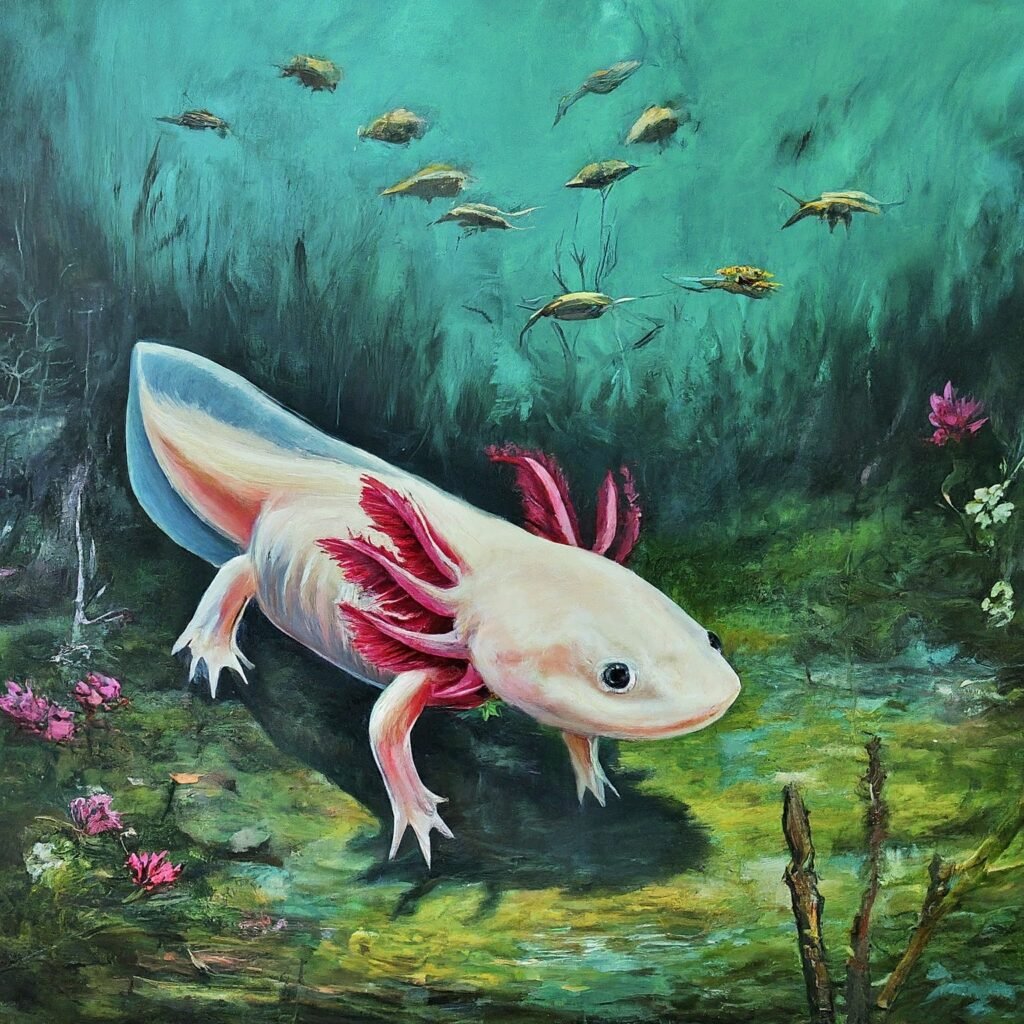
Feeding Your Axolotl: A Captive Culinary Adventure!
So, we’ve learned that axolotls are protein-powered predators in the wild. But how do we translate this knowledge into feeding our pet axolotls in a home aquarium? Don’t worry, it’s not as complicated as it might seem!
Here’s a breakdown of some delicious and nutritious options to keep your little buddy happy and healthy:

Live Food Buffet: (what do axolotls eat)
Bloodworms, earthworms, blackworms, and brine shrimp are all excellent choices. Imagine them like tiny underwater hot dogs – packed with protein and irresistible to axolotls!

Frozen Feast:
For a convenient alternative, thawed bloodworms and daphnia are great options. Think of them like yummy fish sticks for your axolotl!

Pellet Power:
Specially formulated axolotl pellets can be part of a balanced diet. They’re like little vitamin-packed kibble for your pet, providing essential nutrients in an easy-to-eat form.

Important Considerations for a Healthy Axolotl: Beyond the Yum Factor!
We all love to spoil our pets with delicious treats, but when it comes to axolotls, there are a few things to keep in mind beyond just the “yum factor.” Here’s a quick guide to some important considerations for a healthy axolotl diet:
Veggie No-No!
Those tempting veggies in your fridge might seem like a healthy option, but axolotls simply can’t digest them well. Their bodies are designed for protein, and veggies can actually cause health problems.

Raw Meat Risk:
Raw meat can harbor harmful bacteria that can make your axolotl sick. Stick to the protein sources we mentioned earlier that are specifically suited for their needs.

Feeder Fish Frenzy – Not Always a Good Idea: (what do axolotls eat)
Feeder fish can introduce diseases to your axolotl and might even be too big for them to swallow safely. There are much better options available!
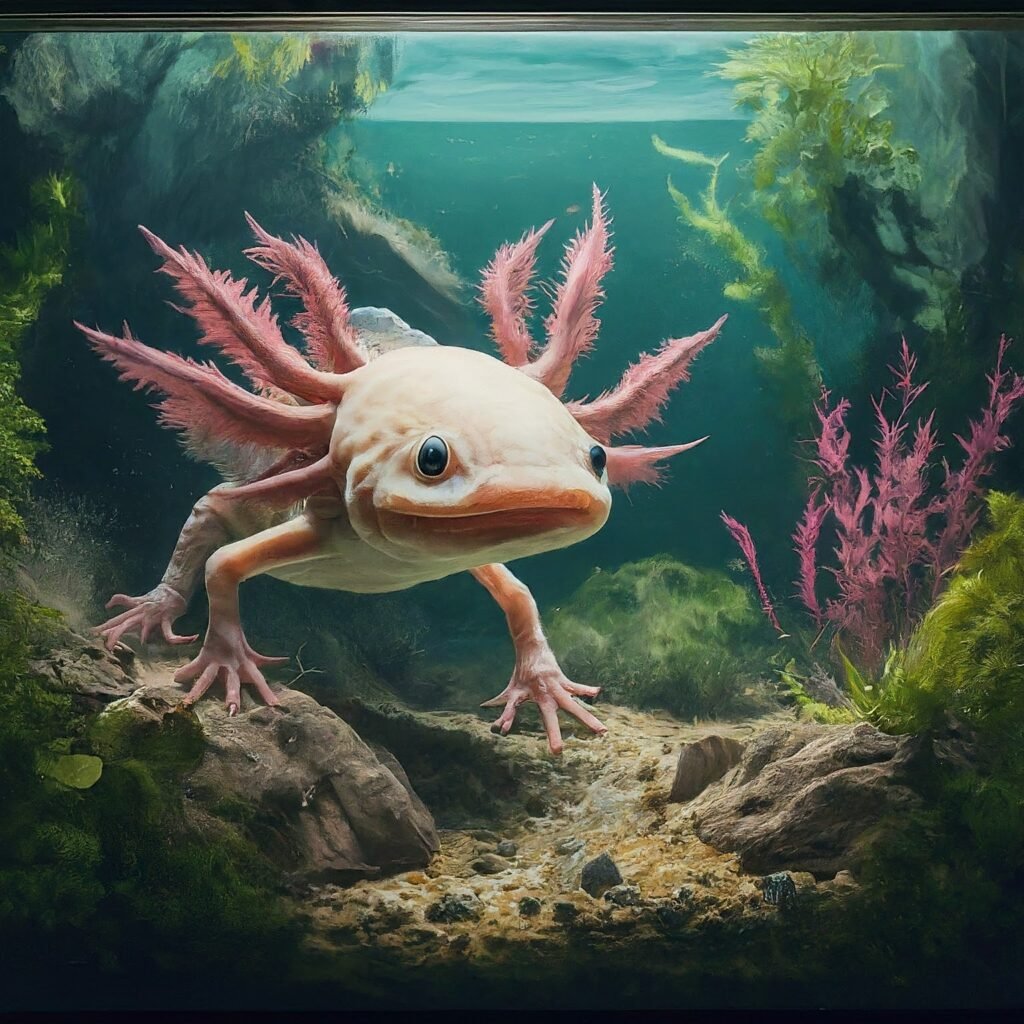
Spotting Malnutrition:
Just like us, axolotls can become malnourished if their diet isn’t balanced. Keep an eye out for signs like a thin body, lethargy, or curved spine. We’ll discuss these signs in more detail later so you can keep your axolotl healthy.

Vitamin Supplements – Not Always Necessary:
A well-rounded diet with a variety of foods usually provides all the vitamins and minerals your axolotl needs. However, there might be situations where a veterinarian recommends supplements. We’ll explore this in more detail later.
Remember, responsible pet ownership means providing your axolotl with the right food to keep them healthy. By following these simple guidelines, you can ensure your little guy gets all the nutrients they need to live a long and happy life!

Addressing Special Needs: Every Axolotl is an Individual!
Just like us humans, axolotls can have special dietary needs. Here’s what to keep in mind if your little guy falls into this category:
Food Allergies:
Believe it or not, axolotls can develop allergies to certain foods, just like some people are allergic to peanuts. If you suspect your axolotl has a food allergy, consult a veterinarian to identify the culprit and adjust their diet accordingly.

Injury Recovery:
Axolotls with injuries might require softer foods that are easier to eat. Chopped earthworms or bloodworms can be a good option during healing periods.

Growth Stages:
Axolotl dietary needs change as they grow. Tiny hatchlings will need much smaller food compared to adult axolotls. We’ll explore this concept of age-appropriate feeding in the next section.
Remember, consulting a veterinarian is always recommended when your axolotl has special needs. They can help you create a personalized feeding plan to ensure your pet gets the proper nutrients to heal, grow, and stay healthy.

A Growing Appetite: Tailoring Meals for Different Axolotl Ages
Just like human babies need different foods than adults, axolotls have changing dietary needs throughout their lives. Here’s a quick guide to keeping your little guy fueled for every stage of growth:
Axolotl Hatchlings (0-3 months):
These tiny guys are more like aquatic crumbs! They need very small food options like brine shrimp or microworms. Think of them as baby food for axolotls!
Juvenile Axolotls (3-12 months):
As they grow, their appetites do too! Introduce larger bloodworms, chopped earthworms, and even small daphnia. Imagine them graduating to goldfish crackers – still small but with a bit more complexity.
Adult Axolotls (1 year and older):
Your axolotl is now a full-fledged adult! A varied diet with earthworms, nightcrawlers cut into pieces, and axolotl pellets will keep them happy and healthy.
Remember, this is just a general guideline. Always monitor your axolotl’s growth and adjust feeding portions accordingly. Some axolotls might be smaller or larger than average for their age.
Beyond the Basics: Responsible Feeding Practices for Happy Axolotls
Feeding your axolotl isn’t just about sprinkling some food in the tank and calling it a day! Here are some responsible practices to keep your little guy healthy and prevent any unwanted surprises:
Spotting a Chubbylotl:
Just like us, axolotls can overeat! Signs of an overfed axolotl might include lethargy, decreased activity, or a bulging belly. If you notice these, adjust their feeding frequency or portion sizes.

Fresh Food Matters: (what do axolotls eat)
Especially when using live food options like bloodworms or brine shrimp, keeping them fresh is essential. Uneaten live food can decompose and foul the water, so make sure to remove any leftovers after feeding time.

Cleanliness is Key: (what do axolotls eat)
Maintain good water quality in your axolotl’s tank. Uneaten food and waste can pollute the water, making your axolotl sick. Regular water changes and tank cleaning are crucial for their health.

Ethical Eating:
Where your feeder insects come from matters! Consider reputable sources that prioritize humane breeding practices. Some pet stores even sell pre-packaged, frozen insect cubes specifically for axolotls, which can be a convenient and ethical option.

Wrapping Up: A Well-Fed and Happy Axolotl!
By providing your axolotl with a balanced diet and following responsible feeding practices, you’re setting them up for a long and healthy life. Remember, these fascinating creatures may look like they could survive on a diet of goldfish crackers, but they truly thrive on a specific nutritional plan.
This guide has hopefully given you a solid foundation for understanding your axolotl’s dietary needs. But remember, every axolotl is unique! Consulting with a veterinarian is always recommended, especially if you have any concerns about your pet’s health or specific needs.
Here are some additional resources to help you on your axolotl care journey:

Reputable Axolotl Care Websites:
Axolotl websites run by experienced breeders or veterinarians can provide valuable information on axolotl care, including diet. Look for sites that are well-established and have a history of providing accurate information.
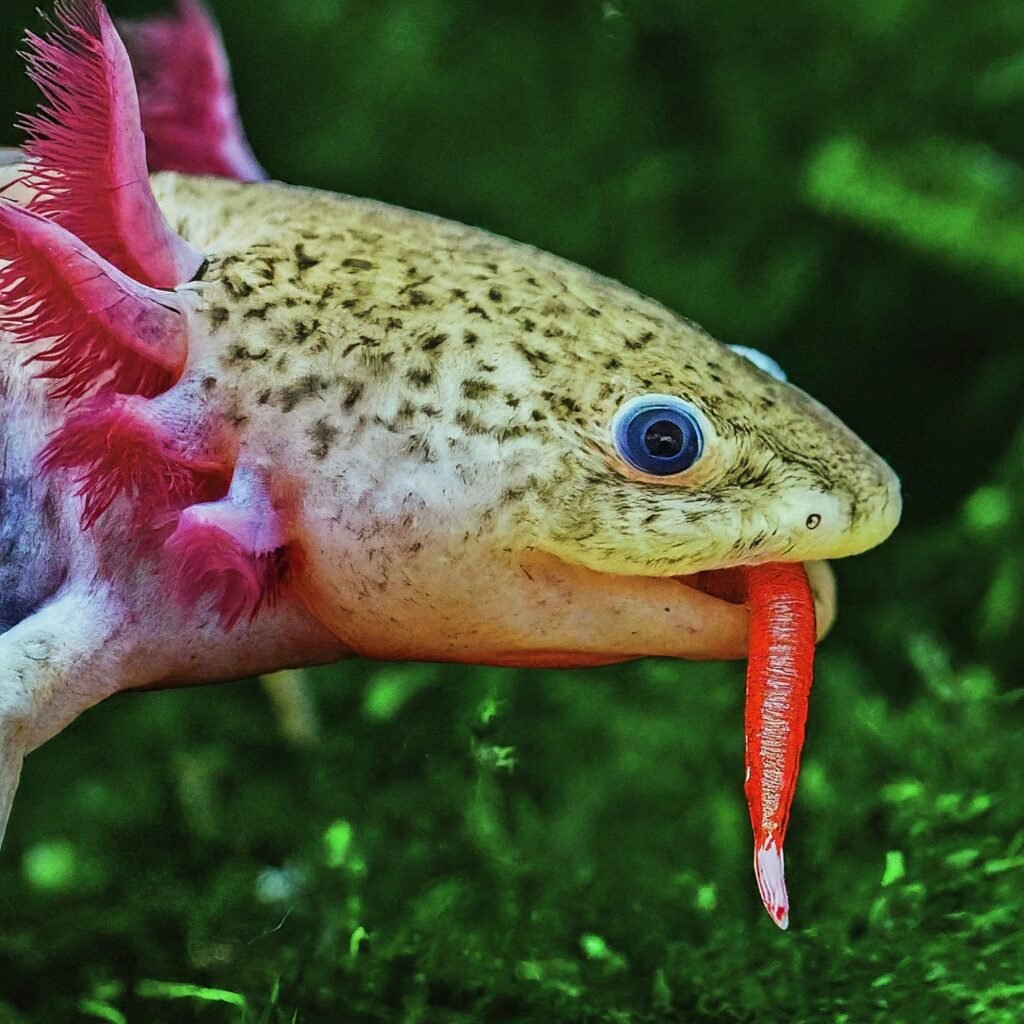
Axolotl Online Forums:
Connecting with other axolotl enthusiasts online can be a great way to learn from their experiences and ask questions. Look for forums with a positive and supportive community.
So, keep exploring the wonderful world of axolotls, and most importantly, have fun caring for your amazing underwater friend!

Tank Essentials: Creating a Happy Axolotl Home
Now that you’ve mastered the art of axolotl cuisine, let’s dive into their living quarters! A happy and healthy axolotl needs a well-maintained tank to thrive. Here are the key things to consider:
The Right-Sized Abode:
Axolotls are surprisingly active swimmers for salamanders. They need enough space to explore. A good rule of thumb is at least 20 gallons for a single axolotl, with an extra 10 gallons for each additional axolotl.

Water Wonderful: what do axolotls eat
Clean, cool, and pristine water is essential. Aim for a temperature between 60-68 degrees Fahrenheit (15-20 degrees Celsius) and invest in a good water filtration system to keep things sparkling clean.

Substratus Sensations:
A bare bottom tank is easiest to clean, but some axolotls like to burrow. If you choose a substrate, avoid anything with sharp edges or small particles that they could accidentally swallow. Opt for smooth pebbles or sand specifically designed for aquariums.
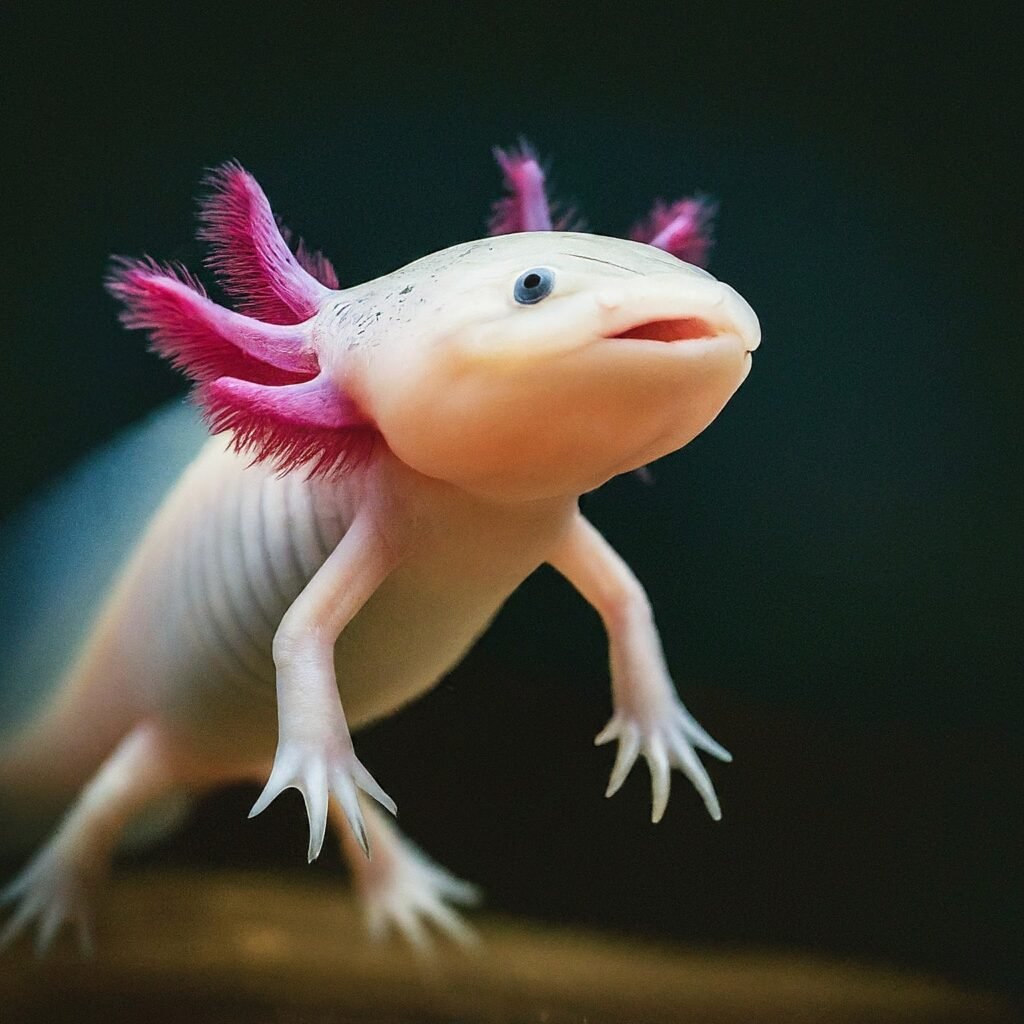
Hiding Havens: what do axolotls eat
Axolotls can be sensitive to light, so provide hiding spots like caves or PVC pipes. This allows them to feel secure and reduce stress.
Live Plant Paradise (Optional):
Live plants can add beauty and improve water quality, but they’re not essential. Axolotls might nibble on some plants, so choose sturdy varieties like Java ferns or Anubias.
Remember, a well-maintained tank is key to a happy and healthy axolotl. By providing the right environment, you can create a little slice of paradise for your underwater pet!

Tank Essentials: Creating a Happy Axolotl Home
Now that you’ve mastered the art of axolotl cuisine, let’s dive into their living quarters! A happy and healthy axolotl needs a well-maintained tank to thrive. Here are the key things to consider:

The Right-Sized Abode: what do axolotls eat
Axolotls are surprisingly active swimmers for salamanders. They need enough space to explore. A good rule of thumb is at least 20 gallons for a single axolotl, with an extra 10 gallons for each additional axolotl.
Water Wonderful:
Clean, cool, and pristine water is essential. Aim for a temperature between 60-68 degrees Fahrenheit (15-20 degrees Celsius) and invest in a good water filtration system to keep things sparkling clean.

Substratus Sensations:
A bare bottom tank is easiest to clean, but some axolotls like to burrow. If you choose a substrate, avoid anything with sharp edges or small particles that they could accidentally swallow. Opt for smooth pebbles or sand specifically designed for aquariums.
Hiding Havens:
Axolotls can be sensitive to light, so provide hiding spots like caves or PVC pipes. This allows them to feel secure and reduce stress.

Live Plant Paradise (Optional): (what do axolotls eat)
Live plants can add beauty and improve water quality, but they’re not essential. Axolotls might nibble on some plants, so choose sturdy varieties like Java ferns or Anubias.
Remember, a well-maintained tank is key to a happy and healthy axolotl. By providing the right environment, you can create a little slice of paradise for your underwater pet!
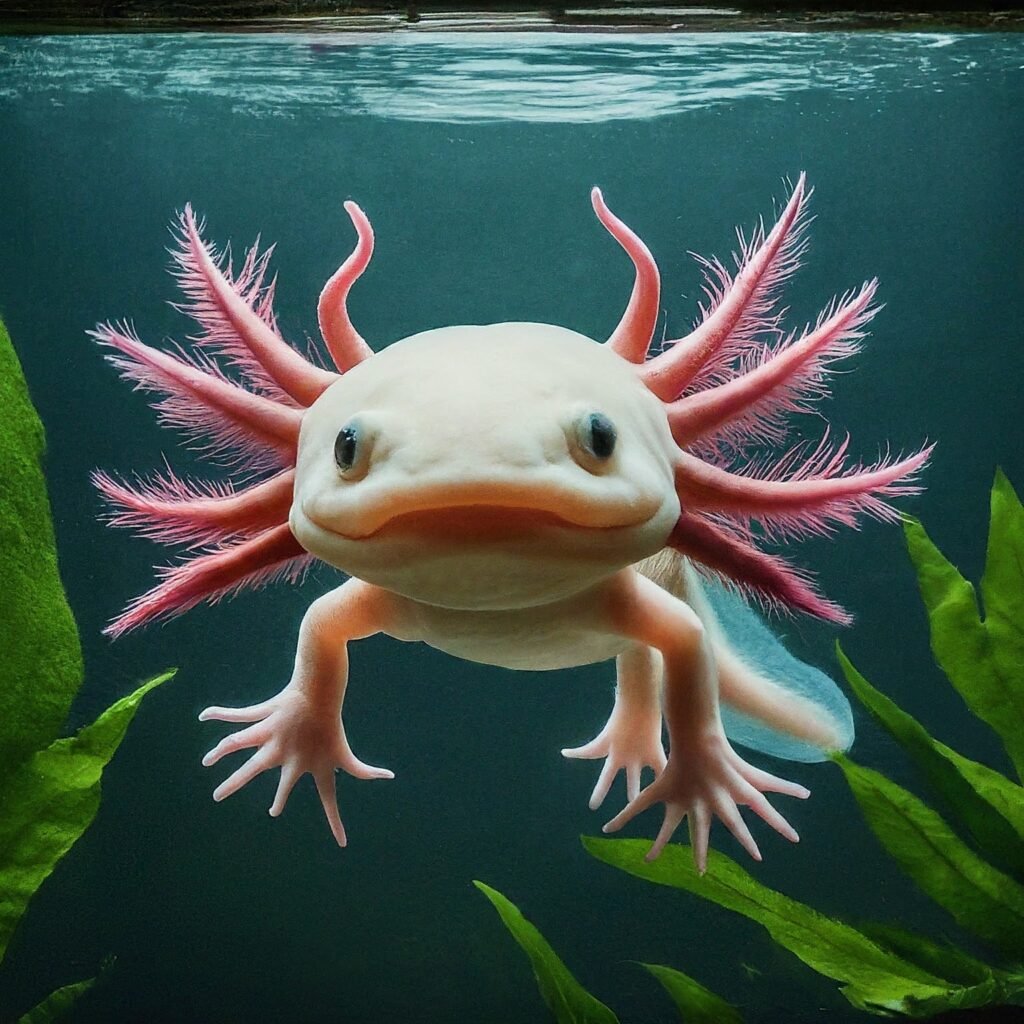
For more articles visit home page.
and if you more information please visit Wikipedia.

